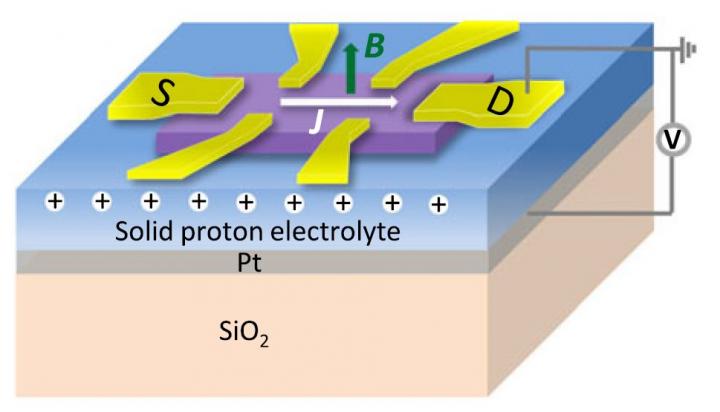Interlayer coupling in FGT successfully increased by insertion of protons

Credit: FLEET
A Chinese-Australian collaboration has demonstrated for the first time that interlayer coupling in a van der Waals (vdW) material can be largely modulated by a protonic gate, which inject protons to devices from an ionic solid.
The discovery opens the way to exciting new uses of vdW materials, with insertion of protons an important new technique, now available for the wider 2D materials research community.
The study was led by FLEET researchers at RMIT, in an ongoing collaboration with FLEET partner organisation High Magnetic Field Laboratory, Chinese Academy of Sciences (CAS).
TUNING INTERLAYER FORCES IN VDW MATERIALS
Van der Waals materials, of which graphite is the most famous, are made of many 2D layers held together by weak, electrostatic forces.
Individual layers of vdW materials can be isolated individually, such as the famous Scotch tape method of producing graphene, or stacked with other materials to form new structures.
“But the same weak interlayer forces that make vdW materials so easy to separate also limit these materials’ applications in future technology,” explains the study’s first author, FLEET Research Fellow Dr Guolin Zheng.
Stronger interlayer coupling in vdW materials would significantly increase potential use in high-temperature devices utilising quantum anomalous Hall effect, and in 2D multiferroics.
The new RMIT-led study demonstrated that coupling in a vdW material, Fe3GeTe2 (FGT) nanoflakes, can be largely modulated by a protonic gate.
With the increase of the protons among layers, interlayer magnetic coupling increases.
“Most strikingly, with more protons inserted in FGT nanoflakes at a higher gate voltage, we observed a rarely seen zero-field cooled exchange bias with very large values,” says co-author A/Prof Lan Wang.
The successful realization of both field-cooled and zero-field cooled exchange bias in FGT implies the interlayer coupling can be largely modulated by gate-induced proton insertion, opening the road to many applications of vdW materials requiring strong interface coupling.
###
THE STUDY
Gate-Tuned Interlayer Coupling in van der Waals Ferromagnet Fe3GeTe2 Nanoflakes was published in APS Physical Review Letters July 2020 (DOI 10.1103/physrevlett.125.047202).
As well as funding from the Australian Research Council the researchers acknowledge the support of the RMIT Micro Nano Research Facility (MNRF) in the Victorian Node of the Australian National Fabrication Facility (ANFF) and the RMIT Microscopy and Microanalysis Facility (RMMF). Theoretical calculations were performed by Professor Yujun Zhao’s group at South China University of Technology.
VAN DER WAALS MATERIALS STUDY AT FLEET
VdW materials and heterostructures are keenly studied at FLEET, an Australian Research Council Centre of Excellence. The Centre for Future Low-Energy Electronics Technologies (FLEET) brings together over a hundred Australian and international experts, with the shared mission to develop a new generation of ultra-low energy electronics.
The impetus behind such work is the increasing challenge of energy used in computation, which uses 5-8% of global electricity and is doubling every decade.
FLEET’s research sits at the very boundary of what is possible in condensed-matter physics. At the nano scale, nanofabrication of functioning devices will be key to the Centre’s success. Specialised techniques needed to integrate novel atomically-thin, 2D materials into high-quality, high-performance nano-devices are coordinated within the Centre’s Enabling technology B, led by RMIT’s A/Prof Lan Wang.
Professor Mingliang Tian is vice-director of the Chinese Academy of Science’s High Magnetic Field Laboratory in Anhui province, China, a partner organisation for FLEET. The FLEET-CAS partnership studies 2D magnetic materials, vdW ferromagnetic heterostructures and topological condensed matter systems.
Media Contact
Errol Hunt
[email protected]
Original Source
http://www.
Related Journal Article
http://dx.




